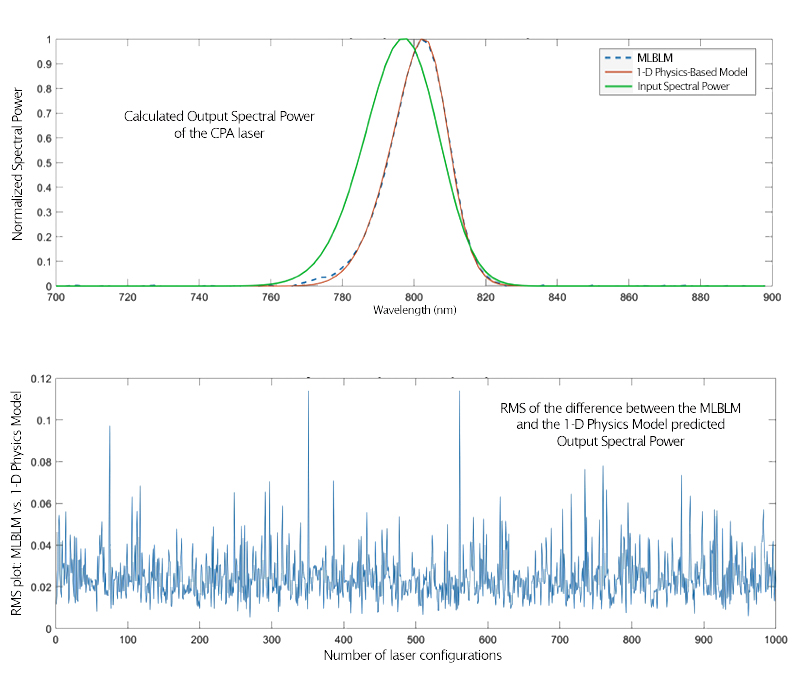Thomas Spinka (16-ERD-038)
Executive Summary
We are developing a new modeling technique for determining the safe operating regime for the optical components of short-pulse, chirped-pulse amplification lasers. This project will enable researchers (using an automated optimization process) to employ the full capabilities of high-energy and high-repetition-rate facilities in laser-driven particle-acceleration experiments, thus benefiting high-energy-density science research.
Project Description
The development of energetic, high-repetition-rate, short-pulse lasers is an emerging field with potential applications in industry, medicine, national security, and high-energy-density science research. Experiments and applications that previously required hours or days to complete may be accomplished in seconds or minutes. Experiments containing many thousands of laser pulses are anticipated. However, controlling the output pulse shape or energy distribution in the laser pulse of such systems comes with additional risks of laser-induced damage to optics. Most solid-state lasers (and particularly those that generate pulses faster than a few shots per day) are designed to operate below the laser-induced damage threshold of the laser optics to avoid initiating optical damage. Because of the extremely short pulse duration, chirped-pulse amplification is frequently employed to lengthen the pulse duration by 10,000 times or more. This lengthening of pulse duration reduces the peak power and intensity of the laser light on optics by the same factor, thereby increasing the resistance to damage of the laser optics. Even so, high-energy, chirped-pulse amplification lasers based on titanium-doped sapphire crystals are typically designed to operate only slightly below the laser-induced damage threshold. Detailed and time-consuming modeling of the laser pulses in space and time are required to verify that a particular configuration will not damage the optics. To address this challenge, we are developing a new technique for determining the safe operating regime of short-pulse, chirped-pulse amplification lasers. In particular, we will develop a high-fidelity model of the portions of an existing titanium-sapphire chirped-pulse amplification laser system that is most sensitive to laser-induced damage. This model will then be exercised with high spatial and temporal resolution for a limited set of laser configurations.
If successful, this project will enable researchers to use the full capabilities of high-repetition-rate petawatt-class laser facilities by performing automated parameter sweeps (e.g., changing the temporal pulse shape and duration) or optimizing an experimental figure-of-merit function (e.g., increasing the peak electron energy in a laser-driven particle-acceleration experiment). Deliverables include (1) a benchmarked and validated model that can be run repeatedly with high spatial and temporal fidelity, and a detailed plan for diagnostics to verify safe operations; (2) an assessment of damage risk on stretched pulse gratings under various conditions such as energy and pulse duration; (3) a modeling method that yields a sufficiently high-fidelity result to determine whether the requested laser configuration is safe to operate; and (4) a process-optimization loop to implement a safe and automated process-control loop. At the successful conclusion of this project, we will have developed a methodology to interpolate high-fidelity laser-propagation modeling for all parameters and demonstrate the applicability of the resultant automated optimization algorithm on a high-energy laser system, ensuring that the laser system remains in a desirable configuration during the automated optimization process.
Mission Relevance
This project offers the development of automated real-time active control over the safe configuration of a high-energy, short-pulse laser, enhancing Lawrence Livermore National Laboratory’s core competency in lasers and optical science and technology. By implementing a safe active feedback for such laser systems, this work helps realize the full potential of the next generation of high-energy, high-repetition-rate, short-pulse lasers, providing users with a novel approach to performing experiments by enabling the laser itself to determine the optimal configuration, rather than relying on highly complex numerical models that may not contain all of the relevant physics. This research is also applicable to the Laboratory's core competency in high-energy-density science, as well as the DOE goal to strengthen the connection between advances in fundamental science and technology innovation.
FY17 Accomplishments and Results
Following a mid-project review, during which the suggestion was made to move beyond the original optimization methods first envisioned and take advantage of recent advances in the field of machine learning, we adjusted our scope accordingly. This enabled us to apply state-of-the-art machine learning to laser-performance modeling and demonstrate a thousandfold speedup over the one-dimensional model. As a result, in FY17 we (1) developed a neural-network algorithm adapted to our high-intensity, chirped-pulse amplification laser system for damage protection and laser-performance modeling; (2) leveraged our one-dimensional physical model to generate a 5,000-element data set to train the machine-learning code, which became a machine-learning-based laser model; (3) began evaluation of this model and demonstrated a speed that was 1,000 times faster than a one-dimensional physical laser model in terms of laser damage and chirped-pulse amplification laser-performance prediction; and (4) deployed and tested relevant new diagnostic and control points for the Laboratory's High-Intensity Laboratory Laser system, and planned to integrate the diagnostic control system with the newly developed code.
Presentations
Galvin, T. 2017. "Adaptive Coherent Control of High Average Power Lasers." Lawrence Livermore National Laboratory Poster Symposium. LLNL-PRES-733079.
   






